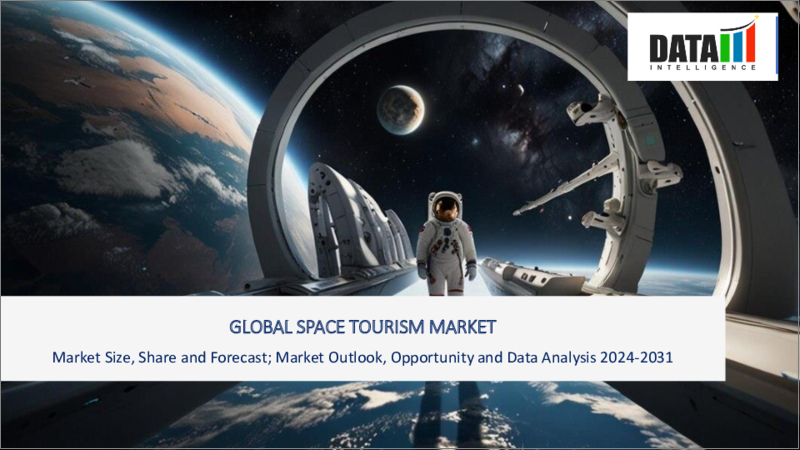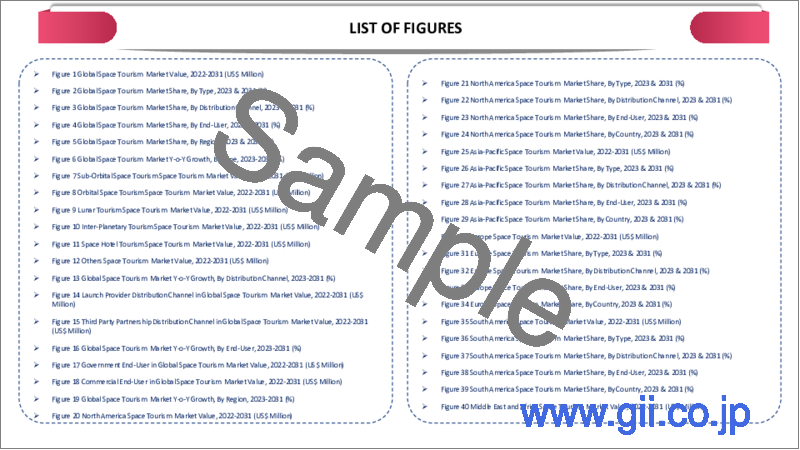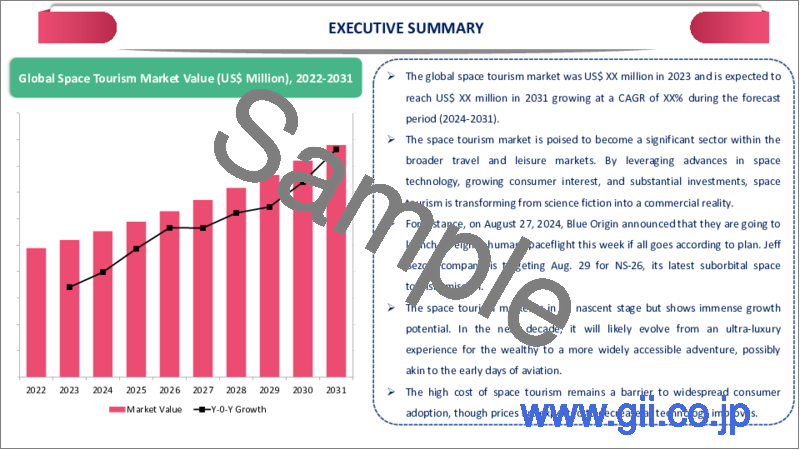|
|
市場調査レポート
商品コード
1459345
宇宙旅行の世界市場-2024-2031年Global Space Tourism Market - 2024-2031 |
||||||
カスタマイズ可能
適宜更新あり
|
|||||||
| 宇宙旅行の世界市場-2024-2031年 |
|
出版日: 2024年04月03日
発行: DataM Intelligence
ページ情報: 英文 210 Pages
納期: 即日から翌営業日
|
- 全表示
- 概要
- 目次
概要
世界の宇宙旅行市場は、2023年に8億4,910万米ドルに達し、2031年には124億400万米ドルに達すると予測され、予測期間2024-2031年のCAGRは40.2%で成長します。
国民の関心と熱意は、宇宙旅行事業、特に打ち上げやミッションの成功が大々的に報道されることによって喚起されます。メディアの高い関心は、宇宙旅行に対する消費者の関心を刺激し、旅行産業における宇宙の可能性に関するニュースの普及に貢献します。旅行業界における宇宙市場は、宇宙船基地、プラットフォーム、領土を含む、宇宙の枠組みでの事業により成長しています。新たな宇宙旅行地が開発され、インフラが整備されることで宇宙旅行活動が成長する可能性があります。
主要な主要企業による製品発表の増加は、予測期間中の市場成長を後押しします。例えば、2023年12月18日、Jeff BezosのBlue Originによって宇宙旅行ロケットが打ち上げられました。Jeff BezosのBlue Originが宇宙旅行ロケットを打ち上げました。Blue Originはニューシェパードロケットを西テキサスの拠点から無人の科学ミッションで打ち上げる計画です。新しく打ち上げられたロケットは安全で信頼できます。
北米が宇宙旅行市場を独占しているのは、主要な主要企業による製品打ち上げの増加によるものです。同地域の主要プレーヤーは宇宙旅行の打ち上げを実施しており、予測期間中の同地域市場の成長を後押ししています。例えば、2021年3月31日、Blue Originは2022年最初の宇宙旅行打ち上げを実施し、6人の観光客を地球外への歓喜の旅に送り出しました。観光客は無重力を体験し、地球の表面から100km上空という最高のワンテージポイントから地球を眺めました。
ダイナミクス
技術の進歩
推進システム、ロケット設計、ロケットにおける技術の進歩は、宇宙旅行をより合理的なものにしました。再利用可能なロケットの技術革新は、宇宙旅行産業の乗り物を含め、ペイロードを宇宙に送り出す費用を根本的に引き下げるもので、スペースXとBlue Beginningによって生み出されています。
これにより、宇宙旅行はより身近で安価なものになります。材料科学と航空宇宙工学の発展により、宇宙旅行機の安全性と信頼性が向上しました。リスク低減戦略の強化、厳格な評価手順、追加された安全対策はすべて、宇宙旅行サービスに対する消費者の信頼を高めるのに役立ち、業界の成長を促しています。スペースX社のドラゴンやボーイング社のスターライナーのような宇宙船の開発により、宇宙旅行は容易になった。
飛行頻度の増加により、宇宙旅行会社はより多くの乗客を受け入れ、より高い収益を上げることができるようになり、市場拡大の原動力となっています。ロケットの内装設計と構造における技術進歩の目標は、軌道上で乗客の快適性と利便性を最大限に高めることです。最先端の生命維持システムや機内設備から人間工学に基づいた座席配置に至るまで、さまざまな進歩を遂げることで、宇宙旅行は乗客にとってより簡単で充実したものになり、より多くのビジネスを呼び込み、業界を前進させます。
ユニークな体験を求める消費者の増加
宇宙飛行は、他に類を見ない素晴らしい体験を提供します。その独自性と排他性から、宇宙飛行は一生に一度の体験とユニークな思い出を求める顧客を惹きつけています。裕福な顧客は、宇宙探査をラグジュアリーツーリズムの最高峰と考えています。宇宙飛行は名声とステータスを提供するため、富裕層は宇宙飛行に惹かれ、ユニークな体験のために割高な料金を支払うことを厭いません。
多くの人々が宇宙飛行を夢のまた夢と考えています。特別な体験を求める旅行者は宇宙旅行に引き寄せられ、「バケットリスト観光」のトレンドの高まりは、ユニークで大胆な活動への需要を高めています。宇宙旅行は、インフルエンサーマーケティングとソーシャルメディアプラットフォームの出現の結果として人気が高まっています。有名人やインフルエンサーがソーシャルメディア上で宇宙飛行体験の最新情報を共有することで、顧客の需要は高まる。興奮と誇大広告が生まれるのです。
宇宙旅行の高額な費用
宇宙旅行には莫大な費用がかかるため、宇宙機関、超富裕層、大きな資金力を持つ一部の営利企業など、一部の人々しか宇宙旅行をする余裕がないです。アクセスが限られているため、宇宙旅行体験や関連サービスの潜在顧客層は限られています。高コストの障壁があるため、宇宙旅行市場は依然としてニッチで、一生に一度の特別な体験を求める富裕層が主な顧客となっています。狭い市場セグメントは、宇宙旅行サービスに対する全体的な需要と宇宙旅行ベンチャーの拡張性を制約します。
高コストが宇宙旅行体験の値ごろ感を低下させ、興味はあっても天文学的なチケット料金を払えない潜在的な顧客の足かせとなっています。このため、宇宙旅行体験の市場はまだ限られており、需要が伸びず、産業が拡大するのを妨げています。宇宙旅行団体は、宇宙旅行に多額の費用がかかるため、採算性や長期的な事業戦略を立てるのに苦労し、財政難に陥っています。宇宙旅行バケーションに高額な料金を課す一方で、多額の支出を回収し、継続的な運営コストを賄う必要があるため、需要と市場へのアクセスはさらに制約を受けます。
目次
目次
第1章 調査手法と調査範囲
第2章 定義と概要
第3章 エグゼクティブサマリー
第4章 市場力学
- 影響要因
- 促進要因
- 技術の進歩
- ユニークな体験を求める消費者の増加
- 抑制要因
- 宇宙旅行のコスト高
- 機会
- 影響分析
- 促進要因
第5章 産業分析
- ポーターのファイブフォース分析
- サプライチェーン分析
- 価格分析
- 規制分析
- ロシア・ウクライナ戦争の影響分析
- DMIの見解
第6章 COVID-19分析
第7章 タイプ別
- 準軌道宇宙旅行
- 軌道宇宙旅行
- 月面旅行
- 惑星間旅行
- 宇宙ホテル旅行
- その他
第8章 流通チャネル別
- 打上げプロバイダー
- サードパーティパートナーシップ
- その他
第9章 エンドユーザー別
- 政府
- 商業
- その他
第10章 地域別
- 北米
- 米国
- カナダ
- メキシコ
- 欧州
- ドイツ
- 英国
- フランス
- イタリア
- スペイン
- その他欧州
- 南米
- ブラジル
- アルゼンチン
- その他南米
- アジア太平洋
- 中国
- インド
- 日本
- オーストラリア
- その他アジア太平洋地域
- 中東・アフリカ
第11章 競合情勢
- 競合シナリオ
- 市況/シェア分析
- M&A分析
第12章 企業プロファイル
- Virgin Galactic
- 会社概要
- 製品ポートフォリオと説明
- 財務概要
- 主な発展
- Boeing
- SPACEX
- BLUE ORIGIN
- SPACE ADVENTURES
- Bigelow Aerospace
- Lockheed Martin Corporation
- ROCKET LAB USA
- MITSUBISHI HEAVY INDUSTRIES LTD.
- Elysium Space, Inc.
第13章 付録
Overview
Global Space Tourism Market reached US$ 849.1 Million in 2023 and is expected to reach US$ 12,404.0 Million by 2031, growing with a CAGR of 40.2% during the forecast period 2024-2031.
Public interest and enthusiasm are sparked by media coverage of space tourism operations, especially widely reported launches and successful missions. High media attention stimulates consumer interest in space travel and helps spread the news about the possibilities for space in the travel industry. The market for space in the travel industry is growing because of ventures made in space framework, including spaceports, platforms and territories. New space tourism locations can be developed and space tourism activities can grow with the help of improved infrastructure.
Growing product launches by the major key players help to boost market growth over the forecast period. For instance, On December 18, 2023, A space tourism rocket was launched by Jeff Bezos' Blue Origin. Jeff Bezos' Blue Origin launched a space tourism rocket. Blue Origin plans to launch its New Shepard rocket on an unmanned scientific mission from its West Texas locations. The newly launched rocket is safe and reliable.
North America is dominating the space tourism market due to growing product launches by major key players. Major key players in the region are conducting space tourism launches which helps to boost regional market growth over the forecast period. For instance, on March 31, 2021, Blue Origin conducted its first space tourism launch of 2022 and sent 6 tourists on a joyride trip outside Earth. The tourist experienced zero gravity and looked at Earth from the best Wantage point available 100 kilometers above the surface of the planet.
Dynamics
Technological Advancements
Technology advancements in propulsion systems, rocket design and rocketry have made space travel more reasonable. Reusable rocket innovation, which radically brings down the expense of sending off payloads into space, including space travel industry vehicles, is being created by SpaceX and Blue Beginning.
The makes space travel more accessible and cheap. The safety and dependability of space tourism vehicles have increased due to developments in materials science and aerospace engineering. Enhanced risk reduction strategies, stringent evaluation procedures and added safety measures all help to boost consumer trust in space tourism offerings, which encourages industry growth. The development of spacecraft like SpaceX's Dragon and Boeing's Starliner has made space travel easier.
The increased flight frequency allows space tourism companies to accommodate more passengers and generate higher revenues, driving market expansion. The goal of technological advancements in rocket interior design and construction is to maximize passenger comfort and convenience while in orbit. The advancements, which vary from cutting-edge life support systems and in-flight places to ergonomic seating arrangements, make space travel easier and more fulfilling for passengers, drawing in more business and propelling the industry forward.
Growing Consumers Demand for Unique Experiences
Space flight provides an incredible experience that is unparalleled. Due to its uniqueness and exclusivity, space flight attracts clients seeking once-in-a-lifetime experiences and unique memories. Affluent clients consider space exploration to be the height of luxury tourism. Because space flight offers prestige and status, high-net-worth individuals are drawn to it and are willing to pay a premium for unique experiences.
Numerous people consider space flight to be a dream come true. Travelers seeking exceptional experiences are drawn to space tourism and the growing "bucket list tourism" trend has raised demand for unique and audacious activities. Space tourism is gaining in popularity as a result of influencer marketing and the emergence of social media platforms. Customers' demand rises when celebrities and influencers share updates about their space flight experiences on social media. The generates excitement and hype.
High Cost Of the Space Travel
Since the enormous expense of space travel, only a small group of people can afford it: space agencies, ultra-high-net-worth individuals and a few commercial enterprises with significant financial resources. The limited accessibility restricts the potential customer base for space travel experiences and related services. Due to the high-cost barrier, the market for space travel remains niche, catering primarily to wealthy individuals seeking exclusive and once-in-a-lifetime experiences. The narrow market segment constrains the overall demand for space travel services and the scalability of space tourism ventures.
High costs diminish the affordability of space travel experiences, deterring potential customers who may be interested but unable to afford the astronomical ticket prices. Due to this, the market for space travel experiences is still limited, which prevents demand from growing and the industry from expanding. Space tourism organizations have financial difficulties due to the substantial costs of space travel, as they struggle to create profitability and long-term business strategies. Demand and market accessibility are further constrained by the requirement to recover significant expenditures and cover continuing operating costs while charging high fees for space travel vacations.
Segment Analysis
The global Space Tourism market is segmented based on type, distribution channel, end-user and region.
Growing Commercial Sector of the Space Tourism
Based on the end-user, the space tourism market is segmented into government, commercial and others. The competition in the space tourism sector has increased with the rise of private space companies like Virgin Galactic, Blue Origin and SpaceX. Due due to competition, more accessible and affordable space tourism services have been created. Space tourism vehicles can now be built in a safer, more reliable and more affordable manner due to technological advancements in spaceflight. Disposable rocket technology and other technologies are being used by businesses to lower the cost of space travel, opening it up to a wider variety of consumers.
Growing Government initiatives to promote space tourism help to boost segment growth over the forecast period. The Canadian government plans to facilitate commercial space launch operations within the country, ensuring they adhere to existing laws and regulations and prioritizing safety, security and environmental sustainability on an individual basis. Throughout the transitional phase, Transport Canada will closely collaborate with other federal departments and agencies to establish comprehensive regulatory prerequisites, safety benchmarks and licensing terms essential for commercial space launch operations in Canada.
Geographical Penetration
North America is Dominating the Space Tourism Market
North America is the dominating region in the space tourism market due to the growing major key player in the region. A small circle of well-known American commercial space companies that are spearheading the development of space tourism infrastructure and technology include Virgin Galactic, SpaceX and Blue Origin. The businesses have made significant financial contributions to space tourism initiatives, including advertising campaigns, launch pads and spacecraft building.
Private aerospace firms in North America have made significant scientific advancements in reusable rocket technology and rocket design, which raises the viability and cost of space tourism. For instance, the cost of space travel for astronauts and space tourists has significantly decreased due to SpaceX's Crew Dragon spacecraft and Falcon 9 rocket. Canada is well-positioned to support space launches due to its geographic location but to effectively handle all aspects of this developing business, its regulatory structure has to be modernized.
Competitive Landscape
The major global players in the market include Virgin Galactic, Boeing, SPACEX, Blue Origin, Space Adventures, Bigelow Aerospace, Lockheed Martin Corporation, Rocket Lab USA, Mitsubishi Heavy Industries Ltd. and Elysium Space, Inc.
COVID-19 Impact Analysis
The introduction of safety security measures, lockdowns and travel restrictions to slow the spread of the virus resulted in operational interruptions for space tourism companies. Delays in launch schedules and postponement or cancellation of scheduled missions resulted in financial losses and uncertainty. For businesses involved in space tourism, the pandemic's effects on the economy created financial difficulties. Due to investor hesitation stemming from market worries and a focus on more pressing pandemic-related issues, several enterprises experienced funding constraints.
The confidence of consumers in travel and tourism, particularly space tourism, was severely impacted by the pandemic. Health and safety worries along with economic uncertainty resulted in a decline in the demand for premium experiences like space travel. Globally, governments shifted funds and attention to the management of the public health emergency and the assistance of sectors of the economy that were directly impacted by the pandemic. Potentially, activities about space tourism have lost out on funding and support in favor of urgent essentials like healthcare and economic recovery.
Russia-Ukraine War Impact Analysis
Increased political instability and tensions as a result of the conflict have an impact on international collaboration on space initiatives, notably space tourism-related ones. Cooperation between countries, commercial space enterprises and space organizations is delayed or postponed. Economic instability is frequently by unpredictable geopolitical circumstances. There's a chance that investors become less willing to support space tourism projects, which would slow down the advancement of infrastructure and related technology.
Russia's involvement in the space industry is significant, particularly regarding launch services. The conflict may disrupt or limit access to Russian launch facilities and services, affecting the ability of space tourism companies to launch missions. Space tourism companies may seek alternative launch providers to reduce dependence on Russian services. The could lead to increased collaboration with other countries and private space companies for launch services, potentially diversifying and strengthening the industry in the long run.
By Type
- Sub-Orbital Space Tourism
- Orbital Space Tourism
- Lunar Tourism
- Inter-Planetary Tourism
- Space Hotel Tourism
- Others
By Distribution Channel
- Launch Provider
- Third Party Partnership
- Others
By End-User
- Government
- Commercial
- Others
By Region
- North America
- U.S.
- Canada
- Mexico
- Europe
- Germany
- UK
- France
- Italy
- Spain
- Rest of Europe
- South America
- Brazil
- Argentina
- Rest of South America
- Asia-Pacific
- China
- India
- Japan
- Australia
- Rest of Asia-Pacific
- Middle East and Africa
Key Developments
- On September 12, 2023, SpaceVIP, a US-based company launched its tourism services in India. The company provides space experiences ranging from space balloons, similar to those offered by Space Perspective, to zero-gravity flights that simulate lunar, Martian and zero-gravity environments.
- On January 26, 2024, Virgin Galactic launched 4 space tourists to the edge of space and back. Virgin's inaugural flight without a company astronaut onboard, saw all four seats in Unity's cabin occupied by paying customers: Robie Vaughn and Neil Kornswiet, American citizens, along with Franz Haider from Austria and Lina Borozdina.
- On June 30, 2023, Virgin Galactic offered space tourism tickets worth over US$ 450k. The company, alongside Blue Origin and SpaceX, targets affluent individuals willing to invest significant amounts for the opportunity to experience supersonic rocket speed and microgravity.
Why Purchase the Report?
- To visualize the global space tourism market segmentation based on type, distribution channel, end-user and region, as well as understand key commercial assets and players.
- Identify commercial opportunities by analyzing trends and co-development.
- Excel data sheet with numerous data points of space tourism market-level with all segments.
- PDF report consists of a comprehensive analysis after exhaustive qualitative interviews and an in-depth study.
- Product mapping available as excel consisting of key products of all the major players.
The global space tourism market report would provide approximately 62 tables, 55 figures and 210 Pages.
Target Audience 2024
- Manufacturers/ Buyers
- Industry Investors/Investment Bankers
- Research Professionals
- Emerging Companies
Table of Contents
Table of Contents
1.Methodology and Scope
- 1.1.Research Methodology
- 1.2.Research Objective and Scope of the Report
2.Definition and Overview
3.Executive Summary
- 3.1.Snippet by Type
- 3.2.Snippet by Distribution Channel
- 3.3.Snippet by End-User
- 3.4.Snippet by Region
4.Dynamics
- 4.1.Impacting Factors
- 4.1.1.Drivers
- 4.1.1.1.Technological Advancements
- 4.1.1.2.Growing Consumers Demand for Unique Experiences
- 4.1.2.Restraints
- 4.1.2.1.High Cost Of the Space Travel
- 4.1.3.Opportunity
- 4.1.4.Impact Analysis
- 4.1.1.Drivers
5.Industry Analysis
- 5.1.Porter's Five Force Analysis
- 5.2.Supply Chain Analysis
- 5.3.Pricing Analysis
- 5.4.Regulatory Analysis
- 5.5.Russia-Ukraine War Impact Analysis
- 5.6.DMI Opinion
6.COVID-19 Analysis
- 6.1.Analysis of COVID-19
- 6.1.1.Scenario Before COVID
- 6.1.2.Scenario During COVID
- 6.1.3.Scenario Post COVID
- 6.2.Pricing Dynamics Amid COVID-19
- 6.3.Demand-Supply Spectrum
- 6.4.Government Initiatives Related to the Market During Pandemic
- 6.5.Manufacturers Strategic Initiatives
- 6.6.Conclusion
7.By Type
- 7.1.Introduction
- 7.1.1.Market Size Analysis and Y-o-Y Growth Analysis (%), By Type
- 7.1.2.Market Attractiveness Index, By Type
- 7.2.Sub-Orbital Space Tourism *
- 7.2.1.Introduction
- 7.2.2.Market Size Analysis and Y-o-Y Growth Analysis (%)
- 7.3.Orbital Space Tourism
- 7.4.Lunar Tourism
- 7.5.Inter-Planetary Tourism
- 7.6.Space Hotel Tourism
- 7.7.Others
8.By Distribution Channel
- 8.1.Introduction
- 8.1.1.Market Size Analysis and Y-o-Y Growth Analysis (%), By Distribution Channel
- 8.1.2.Market Attractiveness Index, By Distribution Channel
- 8.2.Launch Provider *
- 8.2.1.Introduction
- 8.2.2.Market Size Analysis and Y-o-Y Growth Analysis (%)
- 8.3.Third Party Partnership
- 8.4.Others
9.By End-User
- 9.1.Introduction
- 9.1.1.Market Size Analysis and Y-o-Y Growth Analysis (%), By End-User
- 9.1.2.Market Attractiveness Index, By End-User
- 9.2.Government *
- 9.2.1.Introduction
- 9.2.2.Market Size Analysis and Y-o-Y Growth Analysis (%)
- 9.3.Commercial
- 9.4.Others
10.By Region
- 10.1.Introduction
- 10.1.1.Market Size Analysis and Y-o-Y Growth Analysis (%), By Region
- 10.1.2.Market Attractiveness Index, By Region
- 10.2.North America
- 10.2.1.Introduction
- 10.2.2.Key Region-Specific Dynamics
- 10.2.3.Market Size Analysis and Y-o-Y Growth Analysis (%), By Type
- 10.2.4.Market Size Analysis and Y-o-Y Growth Analysis (%), By Distribution Channel
- 10.2.5.Market Size Analysis and Y-o-Y Growth Analysis (%), By End-User
- 10.2.6.Market Size Analysis and Y-o-Y Growth Analysis (%), By Country
- 10.2.6.1.U.S.
- 10.2.6.2.Canada
- 10.2.6.3.Mexico
- 10.3.Europe
- 10.3.1.Introduction
- 10.3.2.Key Region-Specific Dynamics
- 10.3.3.Market Size Analysis and Y-o-Y Growth Analysis (%), By Type
- 10.3.4.Market Size Analysis and Y-o-Y Growth Analysis (%), By Distribution Channel
- 10.3.5.Market Size Analysis and Y-o-Y Growth Analysis (%), By End-User
- 10.3.6.Market Size Analysis and Y-o-Y Growth Analysis (%), By Country
- 10.3.6.1.Germany
- 10.3.6.2.UK
- 10.3.6.3.France
- 10.3.6.4.Italy
- 10.3.6.5.Spain
- 10.3.6.6.Rest of Europe
- 10.4.South America
- 10.4.1.Introduction
- 10.4.2.Key Region-Specific Dynamics
- 10.4.3.Market Size Analysis and Y-o-Y Growth Analysis (%), By Type
- 10.4.4.Market Size Analysis and Y-o-Y Growth Analysis (%), By Distribution Channel
- 10.4.5.Market Size Analysis and Y-o-Y Growth Analysis (%), By End-User
- 10.4.6.Market Size Analysis and Y-o-Y Growth Analysis (%), By Country
- 10.4.6.1.Brazil
- 10.4.6.2.Argentina
- 10.4.6.3.Rest of South America
- 10.5.Asia-Pacific
- 10.5.1.Introduction
- 10.5.2.Key Region-Specific Dynamics
- 10.5.3.Market Size Analysis and Y-o-Y Growth Analysis (%), By Type
- 10.5.4.Market Size Analysis and Y-o-Y Growth Analysis (%), By Distribution Channel
- 10.5.5.Market Size Analysis and Y-o-Y Growth Analysis (%), By End-User
- 10.5.6.Market Size Analysis and Y-o-Y Growth Analysis (%), By Country
- 10.5.6.1.China
- 10.5.6.2.India
- 10.5.6.3.Japan
- 10.5.6.4.Australia
- 10.5.6.5.Rest of Asia-Pacific
- 10.6.Middle East and Africa
- 10.6.1.Introduction
- 10.6.2.Key Region-Specific Dynamics
- 10.6.3.Market Size Analysis and Y-o-Y Growth Analysis (%), By Type
- 10.6.4.Market Size Analysis and Y-o-Y Growth Analysis (%), By Distribution Channel
- 10.6.5.Market Size Analysis and Y-o-Y Growth Analysis (%), By End-User
11.Competitive Landscape
- 11.1.Competitive Scenario
- 11.2.Market Positioning/Share Analysis
- 11.3.Mergers and Acquisitions Analysis
12.Company Profiles
- 12.1.Virgin Galactic*
- 12.1.1.Company Overview
- 12.1.2.Product Portfolio and Description
- 12.1.3.Financial Overview
- 12.1.4.Key Developments
- 12.2.Boeing
- 12.3.SPACEX
- 12.4.BLUE ORIGIN
- 12.5.SPACE ADVENTURES
- 12.6.Bigelow Aerospace
- 12.7.Lockheed Martin Corporation
- 12.8.ROCKET LAB USA
- 12.9.MITSUBISHI HEAVY INDUSTRIES LTD.
- 12.10.Elysium Space, Inc.
LIST NOT EXHAUSTIVE
13.Appendix
- 13.1.About Us and Services
- 13.2.Contact Us






